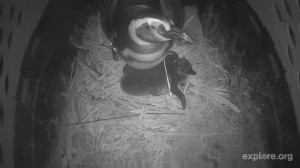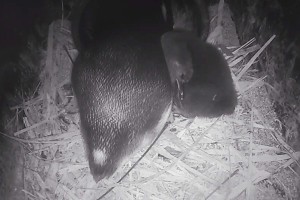11 Things to Know About the Penguin Nest Cam
From our partners at the Aquarium of the Pacific, here are 11 things viewers should know while watching Roxy and Floyd’s Nest Cam – and their adorable new chick!:
- You may have seen both Roxy and Floyd taking turns tending to the nest and even feeding their chick. Magellanic Penguin parents, both mom and dad, will raise their offspring for about 29 days.
- Magellanic Penguins are found south of the equator. When it is summer here, it is winter there. The Aquarium’s Magellanic Penguins have a breeding season opposite to that of in the wild. Day length regulates their breeding season, their molting time, and other behaviors.
- Human parents can get exhausted raising an infant as can penguin parents. Not only do penguin parents have to nourish themselves, but they also have to feed the chick. In the wild, a breeding season can fail if there are not enough fish in the area.
- Initially, Magellanic Penguin chicks are fully dependent on their parents for care. Their eyes remain closed for about one week, and they cannot walk. It will be as much as 36 hours after hatching before they gain weight because during this period the chick is still absorbing the yolk sac and is not yet feeding from the parents.
- The chick will vocalize while in the egg and continues making sounds after hatching. This lets the parents start the bonding process as well as the initiation of the feeding response.
- When a Magellanic Penguin chick hatches, it weighs about 70 to 90 grams. When fully grown, the penguin will weigh between 3.8 and 6.5 kg. Their standing height when full grown is about 24 to 30 inches.
- You may observe Aquarium staff checking on the chick, and Roxy and Floyd getting defensive. Magellanic Penguin parents will protect the chick and the nest as if it was a predator trying to enter. Some of the penguin parents get used to having their chick checked and weighed while other parents may not, so biologists get creative with techniques to occupy and distract the parents.
- When chicks are about a month old, they will be moved to learn to take fish from Aquarium biologists and to care for them until they fledge and are ready to swim. It is also important for the chicks to become accustomed to the biologists feeding them and continue to get used to regular health checks, since the parents will not care for them when they are on exhibit. Likewise, in the wild, the parents go back to sea leaving the chicks to fend for themselves after fledging.
- In the wild, one parent tends to stay with its offspring to fend off predators. When living in burrows, penguin chicks have good protection from predators and cold weather.
- Some of the penguins in the Aquarium’s June Keyes Penguin Habitat were rescued after being stranded off the coast of Brazil. Roxy is one of the rescued penguins who was able to pair up and start a family at the Aquarium. Her partner, Floyd, was born in the U.S. at another institution.
Check out the whole family on the Nest Cam here!





Trackbacks for this post